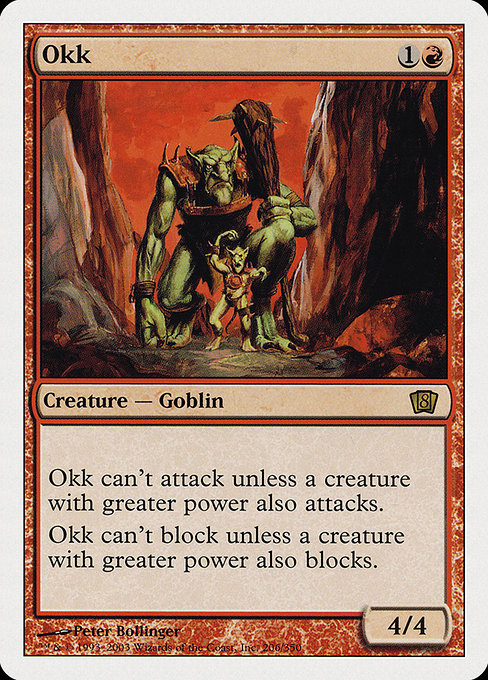
Image courtesy of Scryfall.com
Okk and the Web of Lore: Visualizing Relationships Across MTG Cards
In the grand tapestry of Magic: The Gathering, some relationships are explicit on a single card, while others emerge only when you zoom out and trace the lines between sets, colors, and mechanics. Okk, a rare Goblin from Eighth Edition, is a perfect anchor for a visualization project that maps lore-based connections across the Multiverse. This 2-mana red behemoth—{1}{R}, a 4/4 body—asks you to read the battlefield as a network: power, aggression, and timing become the threads that weave a larger story. 🧙♂️🔥
On the surface, Okk is straightforward: a red 4/4 Goblin with a clever constraint. Its oracle text declares that it “cannot attack unless a creature with greater power also attacks” and “cannot block unless a creature with greater power also blocks.” That single rule creates a relational dance with every other creature you play. To unleash Okk’s offensive potential, you curate a chorus of larger allies, then coordinate their assaults to synchronize power across the board. It’s a microcosm of red’s tempo and risk-reward philosophy, where calculated overextension can pay off in a moment of infernal-sparkled momentum. ⚡
The lore around goblin culture—reckless, communal, and ruthlessly opportunistic—translates beautifully into a network visualization. Okk becomes a hub node: a 4/4 beacon that only activates when connected to stronger power nodes. In graph terms, you’re constructing a layered graph with power deltas as edge weights, alliance as edge presence, and timing as directional constraints. When you map Okk against other red creatures, or even across red cards that grant or boost power, you glimpse a web where decisions ripple outward: one big attack compels a bigger blocking response, which in turn invites a counterplay from the other side. It’s messy, chaotic, and utterly MTG in spirit. 🪄🎲
From a design standpoint, Okk embodies a clever pairing of cost and risk that invites deck builders to think in terms of relationships rather than isolated cards. The set—Eighth Edition, a core print from 2003—carries that white border and 90s-era art direction into a modern curiosity: what if the power a card wields also governs how it interacts with the rest of the battlefield? The rare rarity signals a collectible sweet spot; it’s often affordable for casual nostalgia while still offering strong competition in the right red-heavy shells. The artist, Peter Bollinger, lends a bold, ramshackle vibe to Okk’s world, a visual cue that goblin kinship is loud, colorful, and never simple. The card’s nonfoil print further anchors its status as a (delightfully imperfect) relic you can hold without an eye-wateringly high price tag. 💎
“Power isn’t just a stat here; it’s a relationship metric—one that lets us chart the way goblin alliances shift under pressure.”
For players and lore fans, that relational lens is irresistible. Visualizing Okk within a network means thinking about how a single card can influence the narrative arc of a draft or constructed game. You might pair Okk with a hulking 5/5 or 6/6 behemoth and watch the game tempo tilt in your favor as the greater-power rule gates your aggression in a dramatic, almost operatic way. You might also explore counterplay: how your opponent would deploy creatures with bigger power to deny Okk’s access to combat, or how a spell that temporarily boosts power can unlock new lines of attack. The exercise isn’t just strategic; it’s a living map of MTG relationships that resonates with the way players tell stories at the table. 🎨⚔️
From a collector’s angle, Okk’s status as a rare reprint in 8ed means it’s a snapshot of early 2000s core design: bold, compact, and a touch experimental in how it handles combat. Its mana investment is modest—two mana total—but the payoff hinges on your roster of bigger creatures. If you’re building around power synergy, Okk’s presence in a deck adds a narrative twist: the battlefield is a web that grows smarter the more you invite larger threats to the stage. And while the card itself isn’t a modern staple, its story arc—linking attackers and blockers through power differentials—remains a potent lesson in how mechanics can teach lore through play. The price tag in today’s market reflects its vintage charm more than its utility, underscoring that MTG history is as much about the relationships between cards as it is about raw numbers. 🔥🧩
To keep your real-time visualization session comfortable while you dive into these relationships, consider a desk companion that looks as sharp as your edge-lies. The Neon Gaming Mouse Pad Non-Slip 9.5x8in Anti-Fray is a stylish addition to any MTG setup, pairing neon glow with tactile reliability—perfect for long evenings of deck-building and lore-chat with friends. See how your play space can glow as vividly as your cards' stories. Quality visuals, quick reactions, and a desk that feels like a library of legends. 🏷️🎲
Try exploring Okk’s web of relations in your next game night—start by listing your creatures by power, then draw a simple edge between Okk and any creature that outstrips it. If you buff Okk or the ally beyond that threshold, you unlock new combat lines to test. The exercise may become a habit: a ritual for turning a single card’s constraints into a rich tapestry of play and lore. 🧙♂️💥
Curious to see more about how designers and players map MTG’s evolving relationships? Our network of articles dives into design evolution, board control with repeated triggers, and the echoes of lore across orcish warbands, captain-led white soldiers, and more. The conversation spans from the tactile—cards and board states—to the cerebral—the way digital and physical MTG cultures intersect. And, as always, the journey is part strategy, part storytelling, and part pure nostalgia. 🔎🗺️
Neon Gaming Mouse Pad Non-Slip 9.5x8in Anti-Fray
More from our network
- https://blog.digital-vault.xyz/blog/post/digital-paper-evolution-transforming-modern-design/
- https://blog.digital-vault.xyz/blog/post/jeskai-baller-drives-board-control-with-repeated-triggers/
- https://blog.digital-vault.xyz/blog/post/orcish-conscripts-echoes-of-orcish-warbands-in-mtg-lore/
- https://blog.digital-vault.xyz/blog/post/charting-captain-of-the-watch-white-soldier-card-stats/
- https://crypto-acolytes.xyz/blog/post/why-mounts-and-travel-systems-drive-player-retention/